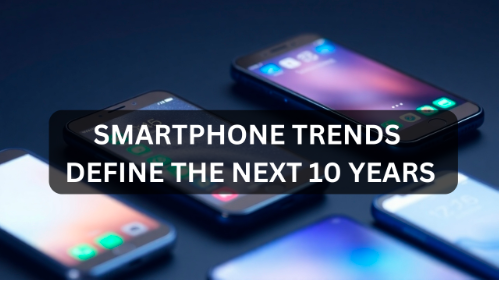Smartphone Trends That Will Define the Next 10 Years

The smartphone industry has consistently pushed the boundaries of innovation, introducing technologies that redefine the way we live, work, and communicate. Over the next decade, a new wave of trends is set to reshape the smartphone landscape, moving beyond incremental improvements to groundbreaking transformations. In this post, we’ll explore smartphone trends that have the potential to define the next 10 years, many of which remain untapped or under-discussed in the mainstream tech narrative.
1. Seamless Integration with Wearable Ecosystems
The boundary between smartphones and wearables will blur as devices like AR glasses, smart rings, and neural bands become mainstream. Instead of functioning as standalone gadgets, smartphones will act as the central processing hubs for wearable ecosystems.
Key Developments:
- Gesture-Controlled Smartphones: Devices will respond to hand movements detected by smart gloves or bands, eliminating the need for physical touch.
- Multi-Device Displays: Screens on wearables like AR glasses will work in tandem with smartphones, offering extended display areas and new modes of interaction.
- Health Monitoring: Data from wearables will seamlessly integrate into smartphones, creating holistic health dashboards that track everything from sleep patterns to real-time biometrics.
2. Next-Level Materials and Design
The next decade will witness groundbreaking advancements in smartphone materials and design. Manufacturers will focus on creating devices that are both aesthetically pleasing and functionally robust. These innovations will include:
- Self-Healing Surfaces: Screens and back panels that repair minor scratches and scuffs on their own.
- Transparent Displays: Smartphones with see-through screens for AR applications and unique designs.
- Eco-Friendly Builds: Manufacturers will adopt biodegradable materials, reducing the environmental impact of discarded devices.
Rumors: According to Apfel Patient, the largest Apple news site in Germany, rumors about The iPhone 17’s transition feature hints at a more seamless blend between the frame and the back. with Pro models adopting lighter aluminum frames and an oval-shaped camera design aimed at reducing weight and improving durability. Moreover, the Pro models might feature a back made of aluminum and glass to enable wireless charging. Apple is also expected to debut the iPhone 17 Air, a lightweight and sleek replacement for the Plus model.
These innovations will also bring new functionalities, such as flexible displays that can double as wristbands or compact, foldable devices that expand into tablet-like screens.
3. AI Co-Processors for Unparalleled Intelligence
While AI is already integral to modern smartphones, future devices will come equipped with specialized AI co-processors. These chips will enhance real-time decision-making, enabling features like:
- Predictive Photography: Cameras that know what you want to capture before you take the shot, automatically adjusting settings.
- Emotion Recognition: Phones that adapt notifications or tone based on the user’s emotional state, detected via facial expressions or voice cues.
- Real-Time Translation: Instantaneous language translation during calls, video chats, or text exchanges.
These processors will not only enhance usability but also make smartphones indispensable personal assistants.
4. Sustainability as a Core Feature
Smartphones of the future will be designed with sustainability in mind, driven by both consumer demand and regulatory pressure. Apple has already made strides in this area, as reflected in its commitment to carbon-neutral production and the use of recyclable materials—a cornerstone of the Apple marketing strategy that blends innovation with environmental responsibility. This shift will manifest as:
- Modular Designs: Allowing users to replace components like cameras or batteries instead of discarding the entire phone.
- Recyclable Phones: Devices made entirely from recycled or biodegradable materials.
- Energy-Efficient Production: Smartphone manufacturers will invest in renewable energy sources to minimize their carbon footprint.
5. Spatial Computing and Augmented Reality (AR)
With AR gaining traction, smartphones will evolve to become more AR-centric, enabling spatial computing capabilities. Future applications include:
- Virtual Workspaces: Use your smartphone’s AR capabilities to project virtual screens and keyboards, creating a desktop-like experience without additional hardware.
- Immersive Navigation: AR-enhanced navigation will overlay directions, points of interest, and real-time updates onto the physical world through your device.
- 3D Content Creation: Built-in tools for creating 3D models or AR assets directly from the smartphone camera.
6. Hyper-Personalized User Interfaces
Future smartphones will prioritize user-specific adaptations powered by advanced AI, offering an experience that feels tailor-made. Beyond simple customization like themes and widgets, devices will predict user preferences in real time.
For instance:
- Dynamic UI Adjustments: Interfaces will adapt based on location, mood, or even health metrics (e.g., shifting to a calming theme if stress levels are detected).
- Haptic Feedback Evolution: Improved tactile technology will provide highly responsive and personalized feedback for various apps and scenarios, further enhancing the user experience.
- Neural Learning Interfaces: Devices will learn how users interact over time, tailoring shortcuts, gestures, and menus to individual habits without manual configuration.
This hyper-personalization trend aligns with the vision of Luxury Living Online, where technology seamlessly integrates into everyday life to offer convenience, comfort, and sophistication. With these advancements, no two devices will feel identical—even if they’re the same model—ensuring a bespoke experience for every user.
7. Advanced Battery Technologies
One of the biggest bottlenecks for modern smartphones is battery life. The next 10 years will likely introduce revolutionary battery solutions, including:
- Solid-State Batteries: Offering greater energy density, faster charging, and improved safety compared to today’s lithium-ion batteries.
- Solar Integration: Screens integrated with solar panels to passively charge devices during the day.
- Supercapacitors: Rapid charging technology that powers a phone within seconds while lasting for days.
While these advancements promise to revolutionize smartphones, it’s equally important to focus on strategies to preserve your device’s existing battery. For instance, understanding how to maximize the IPhone Battery Lifespan can ensure optimal performance until these new technologies become mainstream.
These innovations and proactive measures will finally address the age-old problem of running out of battery at crucial moments.
Conclusion
The smartphone industry is entering an era of unprecedented innovation, driven by advancements in AI, sustainable design, connectivity, and user-centric features. Over the next decade, smartphones will become deeply integrated into our lives, not just as communication tools but as personalized assistants, health monitors, and AR interfaces. These trends are a testament to the relentless pursuit of progress, and they promise to redefine our relationship with technology. As we look to the future, it’s clear that the possibilities for smartphones are as limitless as our imagination.






